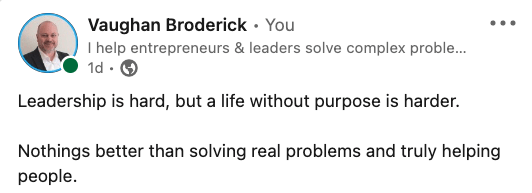Do you find giving feedback stressful?
Does your anxiety cause you to loose sleep, become nervous or doubt yourself as a leader?
You’re not alone.
According to HBR 44% of leaders find giving feedback difficult.
And, 21% avoid giving negative feedback at all.
The surprising thing is that employees prefer to get negative feedback over no feedback at all.
That said, leaders that strike the right balance between praise and criticism are seen as more effective by their team.
Today I’m sharing:
- 5 useful frameworks leaders use to give feedback that builds a high-performing culture.
- 5 tips to give effective feedback so you can reduce stress and sleep better.
Read time: 5 minutes (or less) 👇
Let’s get going!
5 Feedback Frameworks

Try these out to help you deliver more effective (and less anxious) feedback.
Feedback Framework 1 - SBI
The popular SBI model offers a simple 3-step framework to give constructive feedback.
Situation: Identify the context. I.e., “During yesterday’s meeting, I noticed…”
Behaviour: Describe the behaviour that you observed. I.e., “During yesterday’s meeting, I noticed that you could not provide the detail of progress towards your goals.”
Impact: Define the behaviour’s impact on other people or the organisation. I.e., “During yesterday’s meeting, I noticed that you could not provide the detail of progress towards your goals. It would have been a great opportunity for you to build confidence for your team.“
Feedback Framework 2 - SAID
The SAID model focuses on strengths and provides discussion for improvement.
Strengths: Recognise the employee’s skill and intention. I.e., “I recognise that you have great attention to detail, which has always helped us to get the report completed accurately.”
Action: Identify what your feedback is about. I.e., “I recognise that you have great attention to detail, which has always helped us to get the report completed accurately. However, yesterday, I noticed that the quarterly report had several grammatical errors.”
Impact – outline the effect of the issue. I.e., “I recognise that you have great attention to detail, which has always helped us to get the report completed accurately. However, yesterday, I noticed that the quarterly report had several grammatical errors. This may cause the stakeholders to lack confidence in us.”
Development – suggest a way forward. I.e., “I recognise that you have great attention to detail, which has always helped us to get the report completed accurately. However, yesterday, I noticed that the quarterly report had several grammatical errors. This may cause the stakeholders to lack confidence in us. Perhaps next time, we could include a process of using Grammarly and having a co-worker read through it before sending it out.”
Feedback Framework 3 - I like / I wish / What if

My favourite method for gaining feedback when critiquing ideas, prototypes or workshops is the I like / I wish / What if model.
It also uses first-person statements to avoid ‘pointing’ at someone else.
I like – “I like how we all got to learn more about each other”.
I wish – “I wish that we could have had more time for open discussion.”
What if – “What if we could allocate more time at the end of the next workshop?”
Feedback Framework 4 - CRC
Some leaders use the CRC (praise, critique, praise sandwich) model for quarterly team-building appraisals.
It is also the foundation of feedback used at toastmasters clubs.
Commend – What is something that the person is doing well? i.e. “Pete is very open and sharing of information.”
Recommend – What would you recommend they improve? “It would be great if you could slow down when discussing complex matters.”
Commend – Finish with more positive feedback. “Pete is someone I can trust to turn up on time to start work.”
Feedback Framework 5 - SKS
The SKS model is more action orientated and should be used appropriately to avoid the person feeling overly criticised.
What should the person stop doing – “It might help more people understand what you’re meaning if you used less technical words.”
What should the person keep doing – “Your passion when you deliver presentations is energising.”
What should the person start doing – “It’s great that you have an agenda when people arrive. Could an agenda be sent out in advance so others can prepare?”
5 Tips to Give Effective Feedback

Here are 5 B’s to consider when delivering feedback.
1) Be Empathetic.
The person receiving the feedback will likely be as uncomfortable as you are.
As long as you are coming from a place of wanting them to succeed, they will likely respond openly.
2) Be Specific.
Make sure that you have personally observed the behaviour that requires feedback.
And, don’t use ambiguous statements when talking about the impact or desired behaviours.
3) Be Curious.
Leave room for discussion and new information.
Perhaps, the person can even present their own ideas about future behaviour.
4) Be Prepared.
Your confidence will grow when you know that you have had time to gather information and reflect about what outcomes you are looking for.
Consider how the person may respond to the feedback and how you will manage the situation.
5) Be Future-focused.
I believe that most people want to do a great job.
Focusing on helping them get there will be more advantageous for everyone.
The short of it
- Reduce your anxiety by using a feedback framework that matches the situation and your style.
- Think about the 5B’s to be more effective when giving feedback.
If you enjoyed this newsletter, please share it with 1 other person.
That’s all.
Let’s lead with intention together.
🥇 LinkedIn Tip of the Week 🥇

🔥Feedback Quote🔥
“Feedback is the breakfast of champions.” – Ken Blanchard
By the way, I’m working on a design thinking online bootcamp for early 2023.
It is based around the innovative DUCTRI Model.
You can grab your spot here.

